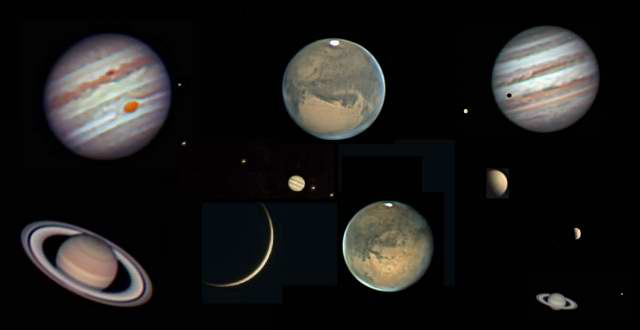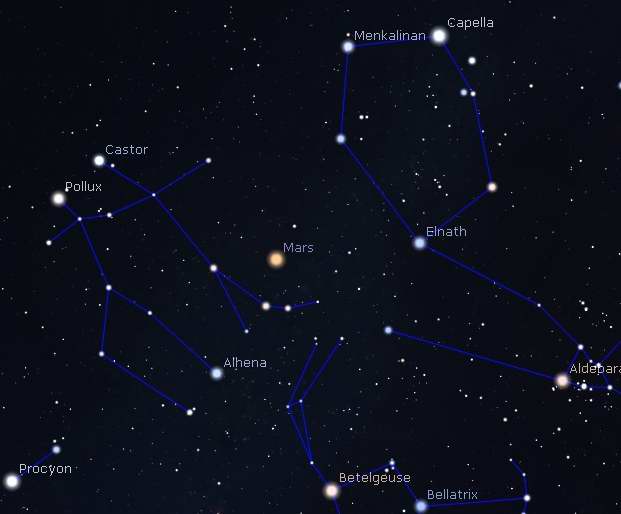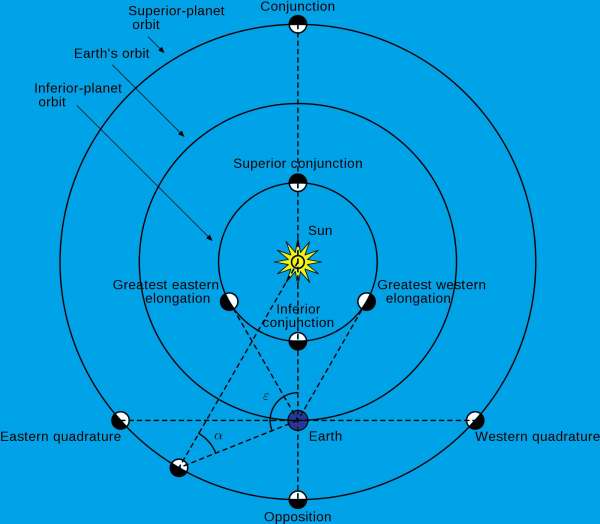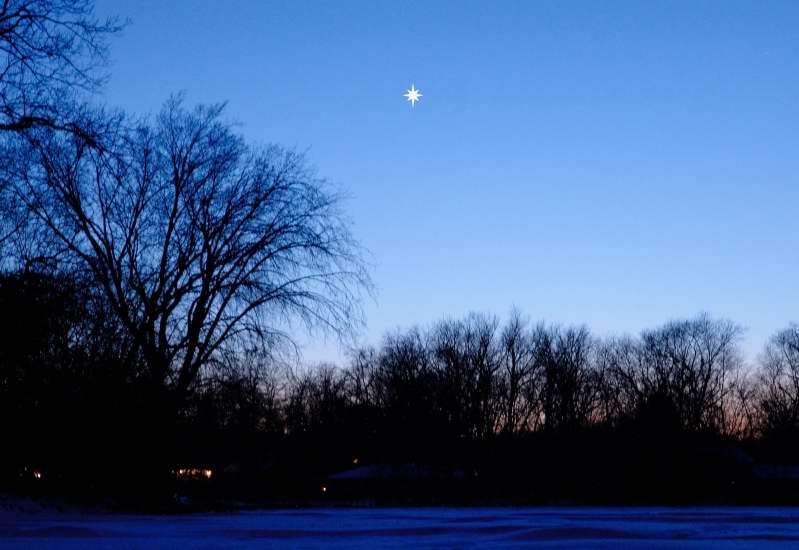Beginner's Guide
Solar System - Planets
The Planets
Though the Sun and Moon are the large showcase objects in the sky because of their large apparent sizes, the planets are many amateurs favorites. Even in the smallest telescopes you can see the rings of Saturn, the moons of Jupiter and the belts on its surface, the phases of Venus, and details on Mars. As we stated earlier, when amateur astronomers are asked what got them into astronomy, the leading answer is seeing the moon in a telescope, but others will answer seeing Saturn and its rings or Jupiter and its moons in a telescope. Though the experience of viewing the moon is fairly universal, Jupiter and even Saturn are not. Some people are disappointed saying, "They're so tiny!" But a budding amateur astronomer will be awestruck by the view of them.
One great thing about observing the planets is that you don't need dark skies to enjoy the views. You don't need a location with few artificial lights and you don't need a moonless night. Venus, Jupiter, Saturn, Mars, and Mercury are the planets which are readily seen by the naked-eye and all of them at a casual glance look like stars. Their existence have been known through much of antiquity because their defining characteristic is that they don't stay in one position in the sky. In fact the name planet comes from the Greek and it means wanderer.
Identifying a Planet
Since planets look like other stars in the sky, how can you identify them? Here are some of the ways, in no particular sequence.
-
Planets move. As we've stated, it's in the name. But this is not a great way to identify them as you won't see the motion
within a given night. You have to plot it's position and then several nights later check to see if it's moved. If you see something that shows
movement to your eye, that is not a planet. It is either a satellite or airplane. Below shows the position of Mars on 3 separate nights so you
can clearly see the motion against the background stars.
-
Planets follow a track in the sky we call the
ecliptic path which is technically the Earth's orbital plane as it circles the Sun. The Sun and Moon
follow this same path! That is because our solar system is pretty much
on the same plane (but not exactly). That path goes through just 13 constellations and 12 of them you should probably know:
Aries, Taurus, Gemini, Cancer, Leo, Virgo, Libra, Scorpius, Sagittarius, Capricornus, Aquarius and Pisces. These are the constellations of the Zodiac.
The 13th constellation is Ophiuchus.
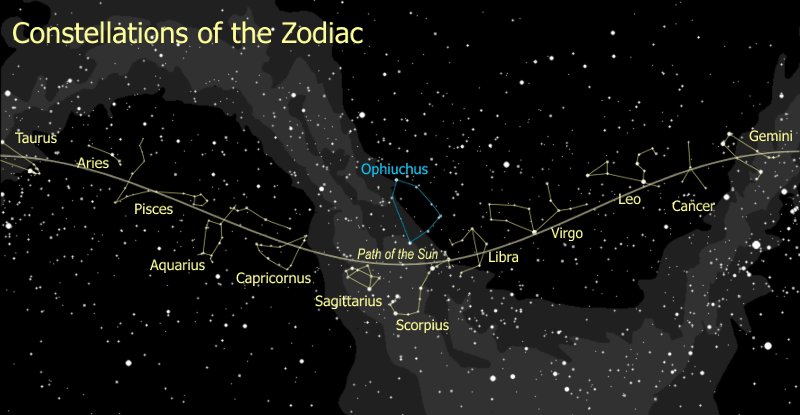
- Planets usually don't twinkle like stars. Stars twinkle with the seeing which is a qualitative measure of the motion of the air in the atmosphere. As they are merely pinpoints of light, that beam is easily distorted. Planets generally don't twinkle. And on those rare occasions when they do, the stars will be twinkling a lot more than usual. The ancients surely noticed this discrepancy, but couldn't have known the reason because they didn't have a telescope which shows a planet is a disc and not a pinpoint of light. The disc of light make that light path more difficult to distort.
- That "star" doesn't belong there. Once you know what a constellation looks like, any "new" star appearing there will be obvious. It doesn't necessarily mean it's a planet, but an airplane or satellite will have detectable motion. And it is possible that it's a nova, but that is highly unlikely due to the rarity of that event.
- If you're not familiar with all the constellations, check the position against an atlas, either on paper or on a computer or smartphone. A planetarium program will show the sky at the current time so it will show the planet in its exact position.
- Look at it in a telescope!
Planets - Inferior and Superior
Simply: an inferior planet is one whose orbit lies closer to the Sun than Earth so Mercury and Venus. A superior planet is one whose orbit lies farther from our orbit. Sometimes you'll see the terms inner and outer used.
The big deal is this effects the motion of a planet when we see it from Earth. An inferior planet (i.e., Mercury and Venus) is never seen in opposition and doesn't wander too far from the Sun. You can only see those planets either in the early evening (in the west) or early morning before sunrise (in the east). A superior planet can be see anywhere along the ecliptic path. The most significant point is called opposition which means it's opposite the Sun. The apparent size of a superior planet is at maximum when at opposition. And its brightness will also be at maximum. This is particularly significant for the planet Mars.
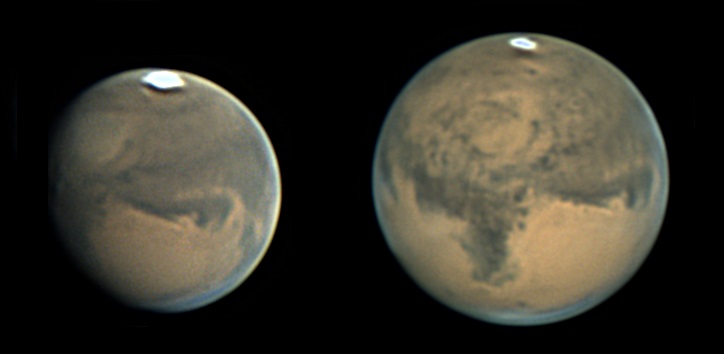 The other effect is the planet phases. Venus and Mercury go through all the same phases as our moon, except the size is not the same. The planets are smallest
when in the full phase and largest when they are a crescent. As you can see from the diagram this is because when they are crescents they are closest.
The superior planets have basically just two phases: gibbous and full, as
shown in the two images of Mars.
The other effect is the planet phases. Venus and Mercury go through all the same phases as our moon, except the size is not the same. The planets are smallest
when in the full phase and largest when they are a crescent. As you can see from the diagram this is because when they are crescents they are closest.
The superior planets have basically just two phases: gibbous and full, as
shown in the two images of Mars.
Jupiter
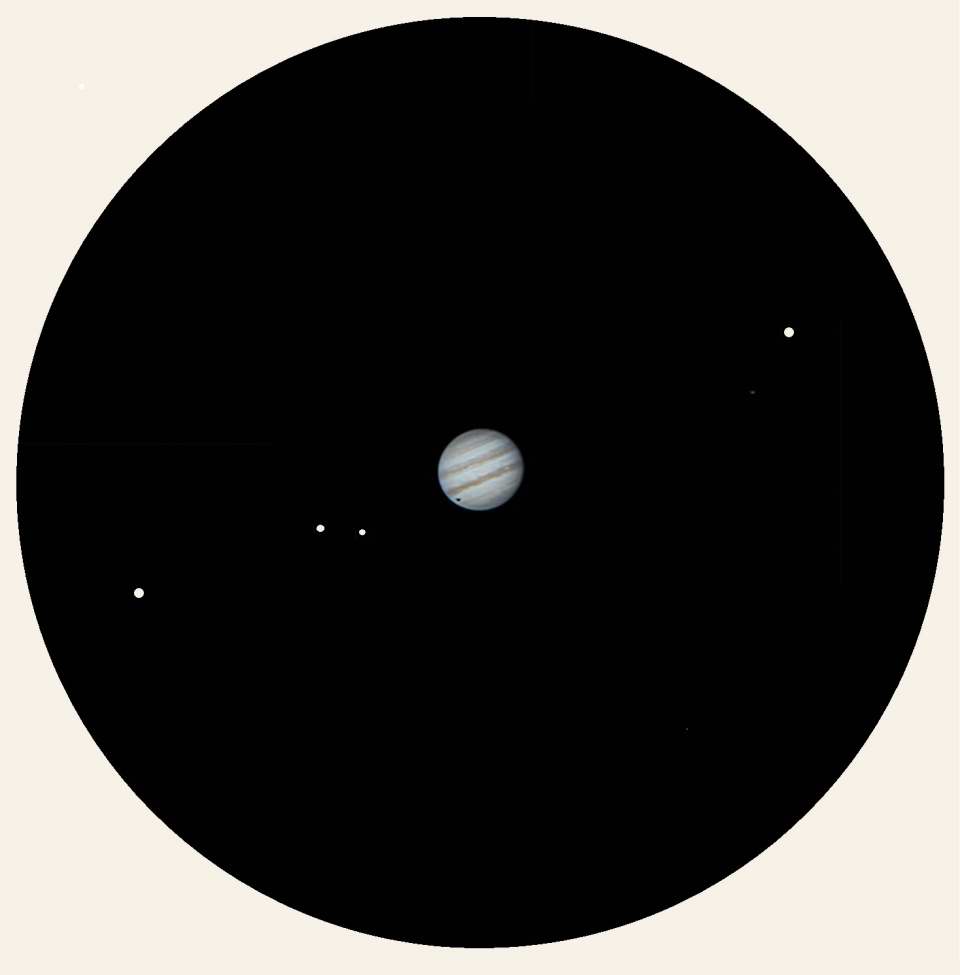 Jupiter is easy to spot in the sky. It shines brightly with a yellowish hue with only Venus being brighter and on rare exceptions Mars.
In binoculars you can actually make out the disc of the planet and a couple of Jupiter's moons can be seen.
Jupiter is easy to spot in the sky. It shines brightly with a yellowish hue with only Venus being brighter and on rare exceptions Mars.
In binoculars you can actually make out the disc of the planet and a couple of Jupiter's moons can be seen.
But the view in even a small telescope is so much better. Jupiter shows its somewhat flattened disc (caused by the high speed of rotation), various belts along the face, and occasionally you can see the Great Red Spot. The other thing that any telescope will show is the 4 Galilean moons, named that because they were discovered by Galileo in 1610. Jupiter has an orbital axis tilt of just 3° so it isn't rare to see a moon's shadow on the face of the planet or see one slip behind the disc.
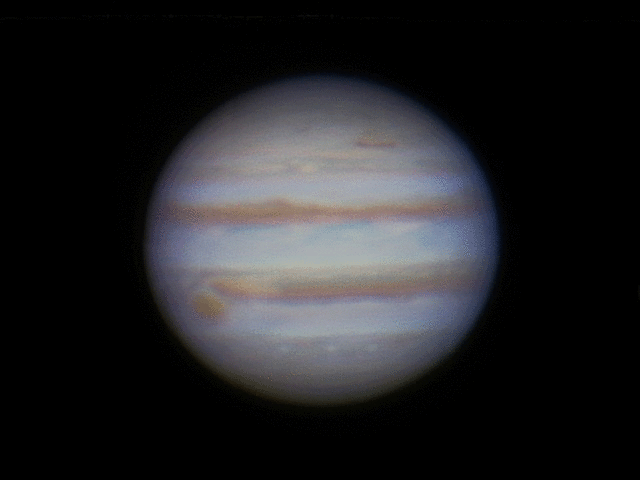 Observing
Jupiter allows something unique to planets: near real-time viewing of
changes. Because of it's fast rotation (just under 10 hours) and the fact
that you can see details in the clouds plus the Great Red Spot, within even
an hour the rotation is very to detect. The image to the left was taken at the MAS Observatory by member Tamas Kriska. It is a movie comprised
of a a series of individual images taken over 4 hours combined.
Observing
Jupiter allows something unique to planets: near real-time viewing of
changes. Because of it's fast rotation (just under 10 hours) and the fact
that you can see details in the clouds plus the Great Red Spot, within even
an hour the rotation is very to detect. The image to the left was taken at the MAS Observatory by member Tamas Kriska. It is a movie comprised
of a a series of individual images taken over 4 hours combined.
Jupiter's inner most moon, Io, offers another opportunity. It orbits the planet in just 42 hours. Consequently even over just an hour of observing you can detect the motion. To see the current positions of Jupiter's satellites, Sky & Telescope magazine has app you can use. Click/tap here to go to the page where you can either launch the app for free on your web browser or buy the app for your mobile device (currently iPhone only) for a small fee.
Jupiter Fact Sheet
- Gas Giant planet with a thick atmosphere
- Fifth planet from the Sun
- Largest planet
- Distance to the Sun : 460 to 508 million miles (741 to 817 million km)
- Distance from Earth: 365 to 601 million miles
- Opposition Distance: 365 to 414 million miles (587 to 667 million km)
- Diameter: 86,882 miles (139,822 km)
- Revolution period: 11.86 years
- Rotation period: 9 hours 55 minutes
- Brightness: -2.94 to -1.66
- Apparent Size: 30.5" to 50"
- Moons: 79 as of 2018
Saturn
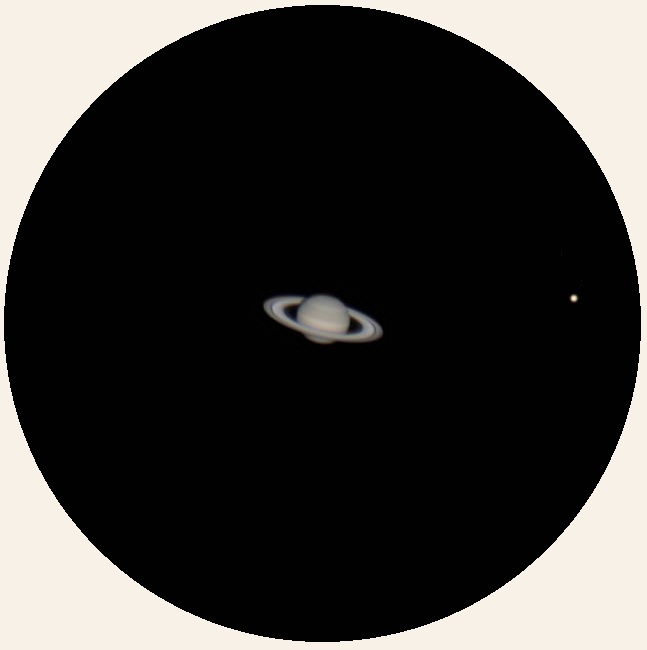 We are very fortunate that we have a planet like Saturn in our solar system. If you are not totally amazed by the sight of Saturn in a telescope
to see the rings, than astronomy might not be for you. Binoculars that magnify 10-12X will show the planet as a small slightly non-circular disk
and you might be able to spot its large moon Titan, but that's about it. To see the rings you need a telescope with an eyepiece giving at
least
30X.
We are very fortunate that we have a planet like Saturn in our solar system. If you are not totally amazed by the sight of Saturn in a telescope
to see the rings, than astronomy might not be for you. Binoculars that magnify 10-12X will show the planet as a small slightly non-circular disk
and you might be able to spot its large moon Titan, but that's about it. To see the rings you need a telescope with an eyepiece giving at
least
30X.
Saturn is one of 4 Gas Giant planets, called that because they primarily composed of hydrogen and helium. It has bands like Jupiter, but they are much fainter and not easy to see.
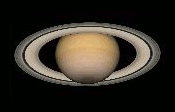 In a small telescope Saturn's rings will probably
appear to be just a ring. The biggest feature of the rings is Cassini's Division. But with very good seeing
higher power, you might be able to see it. A larger telescope which gives better resolution will make it easier. However, the rings are not
aways open as is almost always seen in photographs. Saturn has a 25.7° tilt to its orbit so the angle can vary from 25.7° when fully open and
virtually invisible when it's edge on. The animation shown here shows the 29.5 year cycle. There is another effect from this cycle and its the brightness.
Saturn will be brightest when the rings are fully open and be at minimum when the rings are closed.
In a small telescope Saturn's rings will probably
appear to be just a ring. The biggest feature of the rings is Cassini's Division. But with very good seeing
higher power, you might be able to see it. A larger telescope which gives better resolution will make it easier. However, the rings are not
aways open as is almost always seen in photographs. Saturn has a 25.7° tilt to its orbit so the angle can vary from 25.7° when fully open and
virtually invisible when it's edge on. The animation shown here shows the 29.5 year cycle. There is another effect from this cycle and its the brightness.
Saturn will be brightest when the rings are fully open and be at minimum when the rings are closed.
It is readily possible to see 5 of Saturn's many moons. Titan is easy at magnitude 8 and be seen in any telescope. But in a dark sky you can also spot Iapetus, Rhea, Dione, and Tethys. Though they may seem relatively bright at magnitude 10-11, the light of Saturn will interfere making it a challenge. To help with identification, Sky & Telescope has a utility showing the positions at any given time. Click/tap here to go to the page where you can either launch the app for free on your web browser or buy the app for your mobile device (currently iPhone only) for a small fee.
Saturn Fact Sheet
- Gas Giant planet with a thick atmosphere
- Sixth planet from the Sun
- Second largest planet
- Distance to the Sun : 841 to 941 million miles (1,352 to 1,512 million km)
- Distance from Earth: 746 to 1,057 million miles (1.2 to 1.7 billion km)
- Opposition Distance: 746 to 841 million miles (1.2 to 1.4 billion km)
- Diameter: 67,575 miles (108,728 km)
- Revolution period: 29.46 years
- Rotation period: 10 hours 33 minutes
- Brightness: −0.55 to +1.17
- Apparent Size: 14.7" to 20.5" (doesn't include the rings)
- Moons: 53 as of 2020, 29 awaiting confirmation
Mars
Mars is tough! Even though this planet is the second closest to Earth, it is a small planet and will almost always look tiny in a small telescope. For any kind of decent view, your observations must be made at opposition which means when a planet is opposite the Sun. These Mars oppositions occur about every two years (780 days) and provide a decent view for about 4 months, 2 months before and after the actual opposition date.
When Mars is at or near opposition it is easy to spot. It's bright and it's very reddish (some people will call the color more orange). At near oppositions Mars will be brighter Jupiter, which is normally the second brightest "star" after Venus. But when it's not at opposition you may find it more challenging to identify. At its dimest, 28 regular stars shine brighter. But in binoculars the reddish color will be evident.
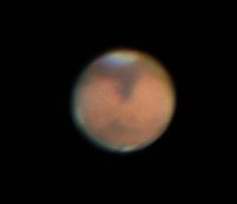 In a small telescope if it's not during the time of opposition, you're lucky to even see the small disk
of Mars and your view will undoubtedly be disappointing. But at oppositions, especially
the closers ones, you can see detail and the polar ice caps. Sometimes you can see both the north and south poles, but Mars tilt is
25°, about the same as Earth's: 23.5° sometimes Mars axis is pointing toward us so we only see the North ice cap. If it's pointing away we
see the South ice cap. Those polar ice caps vary in size with the Martian seasons.
In a small telescope if it's not during the time of opposition, you're lucky to even see the small disk
of Mars and your view will undoubtedly be disappointing. But at oppositions, especially
the closers ones, you can see detail and the polar ice caps. Sometimes you can see both the north and south poles, but Mars tilt is
25°, about the same as Earth's: 23.5° sometimes Mars axis is pointing toward us so we only see the North ice cap. If it's pointing away we
see the South ice cap. Those polar ice caps vary in size with the Martian seasons.
Mars is often observed with the help of filters. A red filter will enhance the darker areas, while a blue or green filter will enhance the view of the ice caps.
Mars Fact Sheet
- Terrestrial planet with a thin atmosphere
- Fourth planet from the Sun
- Distance to the Sun : 128 to 155 miles (207 to 249 million km)
- Distance from Earth: 34 to 248 million miles
- Opposition Distance: 34 to 62 million miles (56 to 101 million km)
- Diameter: 4,212 miles (6,794 km) ... about half that of Earth!
- Revolution period: 687 days
- Rotation period: 24 hours, 37 min
- Brightness: −2.94 to +1.86
- Apparent Size: 3.5" to 25"
- Time between oppositions: 780 days (or 2 years and 50 days)
- Close oppositions: 15-17 years
- Moons: 2 - Phobos and Deimos
Venus
Have you seen Venus shining brightly in the sky? The odds are you have. Venus is the brightest "star" in the sky, shining at magnitude -4.9 at maximum. Only the Moon and Sun are brighter. But ironically it's actually easy to miss exactly because it's so bright. People see it and immediately think, "That's too bright to be a regular star," and of course they're not wrong because it's really a planet. So they will normally mistake it for a plane and maybe even a satellite because they don't keep looking to see it's not moving. Venus and Mercury are labeled inferior planets because their orbits are closer to the Sun than Earth. As a consequence they never wander very far from the Sun. You will only see Venus either just after sunset in the western sky or just before sunrise in the eastern sky.
 Above is a photo collage of Venus in its various phases. As you can see it goes through the same phases as those of the moon, but unlike the
moon the size of the planet varies in size, being the largest when it's a thin crescent. The reason can be seen in the diagram at the right.
And also unlike the moon, Venus is not the brightest when it's in the full phase. It's actually the brightest when it is 25% illuminated which
is the center image of Venus in the banner of 13 phases.
Above is a photo collage of Venus in its various phases. As you can see it goes through the same phases as those of the moon, but unlike the
moon the size of the planet varies in size, being the largest when it's a thin crescent. The reason can be seen in the diagram at the right.
And also unlike the moon, Venus is not the brightest when it's in the full phase. It's actually the brightest when it is 25% illuminated which
is the center image of Venus in the banner of 13 phases.
Why is Venus the brightest planet? Not only is Venus close to the Earth, but it is shrouded in clouds which are very reflective. The downside of these clouds is unfortunately they obscure the surface and there is little detail to be seen in the clouds. So in a telescope Venus simply looks like a tiny moon with no features. There is almost nothing to see in binoculars.
Venus Fact Sheet
- Terrestrial planet with a thick atmosphere
- Second planet from the Sun
- Distance to the Sun : 66.8 to 67.7 million miles (107.5 to 108.9 million km)
- Distance from Earth: 24 (38) to 162 (261) million miles (km)
- Diameter: 3,761 miles (6,051 km) ... just smaller than Earth!
- Revolution period: 243 days
- Rotation period: 224.7 days
- Brightness: −4.92 to −2.98
- Apparent Size: 10" to 64"
- Moons: None
Mercury
 Mercury is the other inferior planet so like Venus doesn't wander far from the Sun. It also goes through the same phases as Venus.
But Mercury is a lot closer to the Sun so it travels faster around the Sun (just 88 days) and it's never far away from the Sun as we see here
on Earth. Consequently Mercury is not easy to see. Whereas we believe everyone has seen Venus (whether they realize it or not), almost no
one has ever seen Mercury. It is so difficult that even some amateur astronomers have never seen it.
Mercury is the other inferior planet so like Venus doesn't wander far from the Sun. It also goes through the same phases as Venus.
But Mercury is a lot closer to the Sun so it travels faster around the Sun (just 88 days) and it's never far away from the Sun as we see here
on Earth. Consequently Mercury is not easy to see. Whereas we believe everyone has seen Venus (whether they realize it or not), almost no
one has ever seen Mercury. It is so difficult that even some amateur astronomers have never seen it.
To have any real chance of seeing this planet, you will have to consult an almanac. Here a planetarium program is extremely helpful as it will not only tell you what days to look, but where in the sky it will appear. But you'll also need a fairly good horizon as it will probably be very low in the sky. And another problem is Mercury doesn't remain visible for many days so your window of opportunity is short. Combine all of that with the interfere of weather, you can see why many people haven't seen it.
With all the work just to see it, you will probably be disappointed by the view in a telescope. As you can see from the 100X diagram, Mercury is tiny and you might even have trouble making out the phase.
Mercury Fact Sheet
- Terrestrial planet with no atmosphere
- First planet from the Sun
- Distance to the Sun : 28.6 to 43.4 million miles (46 to 69.8 million km)
- Distance from Earth: 48 (77) to 138 (222) million miles (km)
- Diameter: 3,033 miles (4,880 km)
- Revolution period: 88 days
- Rotation period: 58.6 days
- Brightness: −2.48 to +7.25
- Apparent Size: 4.7" to 13"
- Moons: None
Uranus
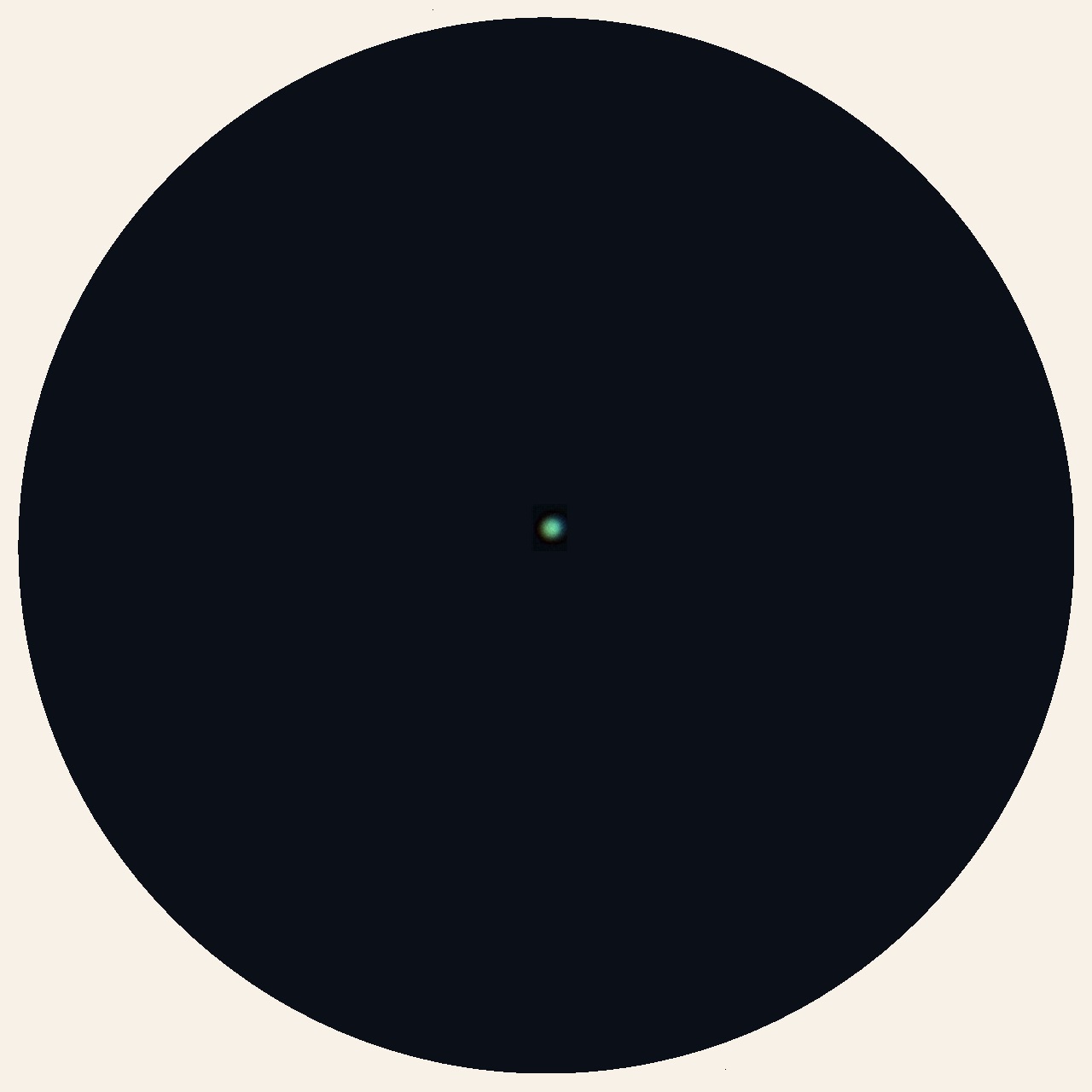 Uranus is one of the four gas giants, but along with Neptune it is commonly referred to as an
Ice Giant.
Uranus was the first planet discovered with a telescope. Though it is visible to the naked-eye, it is faint enough to have been missed by
astronomers through antiquity. We know that it was seen because it was catalogued several times,
most significantly by
John
Flamsteed in 1690 who designated it 34 Tauri, but no one detected the movement.
Uranus is one of the four gas giants, but along with Neptune it is commonly referred to as an
Ice Giant.
Uranus was the first planet discovered with a telescope. Though it is visible to the naked-eye, it is faint enough to have been missed by
astronomers through antiquity. We know that it was seen because it was catalogued several times,
most significantly by
John
Flamsteed in 1690 who designated it 34 Tauri, but no one detected the movement.
Though Uranus is a fairly large planet (3rd largest in the solar system), it is 1.8 billion miles from the Sun so it's apparent size as seen from Earth is very small. In a telescope the best you can do is detect the small greenish disc. Uranus was discovered by William Herschel in 1781 because he didn't appear to be a regular star. He thought it was either a nebulous star or a comet. But four nights later when he looked at it he could see that it had moved so it had to be a comet. Why not a planet? Because a new planet in the solar system was unthinkable.
Uranus Fact Sheet
- Gas Giant planet with a thick atmosphere
- Seventh planet from the Sun
- Third largest planet
- Distance to the Sun : 1,703 to 1,867 million miles (2,741 to 3,004 million km)
- Distance from Earth: 1,604 to 1,962 million miles (2,582 to 3157 million km)
- Opposition Distance: Average 1690 million miles (2,720 million km)
- Diameter: 31,770 miles (51,118 km)
- Revolution period: 84.02 years
- Rotation period: 17 hours 14 minutes
- Brightness: 5.38 to 6.03
- Apparent Size: 3.3" to 4.1"
- Moons: 27
Neptune
Neptune is now considered the farthest planet in our solar system. It is one of the four gas giants, but along with Uranus it is commonly referred to as an Ice Giant. Neptune was discovered in 1846 and we credit the planets discovery to mathematics. Strange perturbations in the orbit of Uranus could be explained by an undiscovered planet. This prediction was championed by John Couch Adams and Urbain Le Verrier, but both of them had difficulty having their predictions taken seriously. Le Verrier, a French mathematician and astronomer, out of frustration being ignored by French compatriots, wrote a letter to Johann Galle of the Berlin Observatory in 1946 with his prediction of its location. On the night the letter was received, it took Galle less than an hour of searching to discover Neptune. We now credit the discovery of Neptune to all three men: Galle, Leverrier, and Adams.
Neptune is just slightly smaller than Uranus so it's a fairly large planet. But at 2.8 billion miles from the Sun that means it's apparent size is only half of Uranus. It is extremely difficult just to detect a disc in a telescope. Most amateurs find Neptune by a star chart.
Neptune Fact Sheet
- Gas Giant planet with a thick atmosphere
- Eighth planet from the Sun
- Fourth largest planet
- Distance to the Sun : 2,762 to 2,825 million miles (4,444 to 4,546 million km)
- Distance from Earth: 2,676 to 2,913 million miles (4,306 to 4,687 million km)
- Opposition Distance: Average 2702 million miles (4,347 million km)
- Diameter: 30,605 miles (49,244 km)
- Revolution period: 164.8 years
- Rotation period: 16 hours 7 minutes
- Brightness: 7.7
- Apparent Size: 2.3"
- Moons: 14

